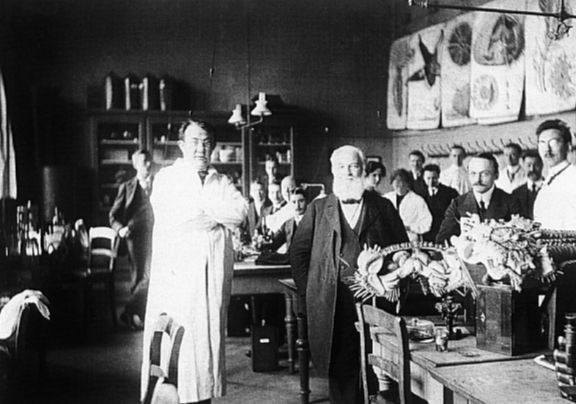
The  microscopic zoology course at Berlin’s Zoological Institute, 1912/1913. Wall charts, models, and specimens were hung up, set up, and made available to students. At the front is Director Franz Eilhard Schulze, to his left department head Wilhelm Berndt.1
microscopic zoology course at Berlin’s Zoological Institute, 1912/1913. Wall charts, models, and specimens were hung up, set up, and made available to students. At the front is Director Franz Eilhard Schulze, to his left department head Wilhelm Berndt.1
The items in a teaching collection fulfil one function above all: to impart knowledge in academic teaching. In order to demonstrate shape and physique, as well as organic composition and functions, the Institute of Biology at Humboldt-Universität zu Berlin still uses models, wall charts, and specimens in seminars and lectures today. They are objects of study, and some of them are truly objects of use – they are hung on walls, mounted, presented, or passed around. Sometimes it only becomes apparent that some of the items are historical objects on closer inspection. Faded labels, cryptic numerical codes like  28.8.5.7-4, and the marks of wear and tear hint at the
28.8.5.7-4, and the marks of wear and tear hint at the  journeys on which these objects have been and point to the eventful histories of some specimens. These histories have been shaped by processes of transfer, on both a functional and spatial level.
journeys on which these objects have been and point to the eventful histories of some specimens. These histories have been shaped by processes of transfer, on both a functional and spatial level.
Inventories, lists, labels, and other forms of  record-keeping played a special role. As paper and object technologies, they documented the procurement of live and dead animals and their specimens, and recorded and made their economic and epistemological value.2 Their purpose was to incorporate these animal objects into the specific collecting framework, and they simultaneously became documents of a development that they themselves governed in their materiality as texts of use.3 But how did these record-keeping media work? What were the systems of order on which they based, and who can understand or read them today? Did the inventories of the teaching collection have special functions due to the nature of the collection?
record-keeping played a special role. As paper and object technologies, they documented the procurement of live and dead animals and their specimens, and recorded and made their economic and epistemological value.2 Their purpose was to incorporate these animal objects into the specific collecting framework, and they simultaneously became documents of a development that they themselves governed in their materiality as texts of use.3 But how did these record-keeping media work? What were the systems of order on which they based, and who can understand or read them today? Did the inventories of the teaching collection have special functions due to the nature of the collection?
In the Zoological Teaching Collection of the Humboldt-Universität zu Berlin, there are historical inventory books that employees began the year the collection was founded, in 1884, to keep ongoing records of the collection’s holdings. Today they provide insights into the work performed to order the collection and contain exciting information about the  history of the Zoological Collection. The teaching collection belonged to the university’s Zoological Institute, which was also founded in 1884 with a focus on academic teaching, which made it unlike other natural history institutions at the time, for example, the Zoological Museum, which primarily served research purposes.
history of the Zoological Collection. The teaching collection belonged to the university’s Zoological Institute, which was also founded in 1884 with a focus on academic teaching, which made it unlike other natural history institutions at the time, for example, the Zoological Museum, which primarily served research purposes.
A total of eight inventories, each of which was assigned a Roman numeral, listed the institute’s complete collection holdings, from specimens, models, and wall charts all the way to instruments and furnishings. They were large, cumbersome books that recorded information over hundreds of pages. The knowledge about the items in the collection written down here is structured by a preprinted table that bears the titles of various categories, which differ depending on the inventory. Three of the inventory books – Inventory of Specimens Chap. V(1), V(2), and VII – were dedicated to animal specimens alone, which, alongside models made from  plastic and
plastic and  papier mâché, as well as wall charts, were particularly relevant to teaching. Structured chronologically by running numbers, they list items from the period 1884-1943. Once a specimen made its way into the teaching collection, it was assigned a number, and institute employees noted down information like ‘description’, ‘location’, ‘preservation’, ‘acquisition’, ‘number’, and ‘price’ in the assigned columns.
papier mâché, as well as wall charts, were particularly relevant to teaching. Structured chronologically by running numbers, they list items from the period 1884-1943. Once a specimen made its way into the teaching collection, it was assigned a number, and institute employees noted down information like ‘description’, ‘location’, ‘preservation’, ‘acquisition’, ‘number’, and ‘price’ in the assigned columns.
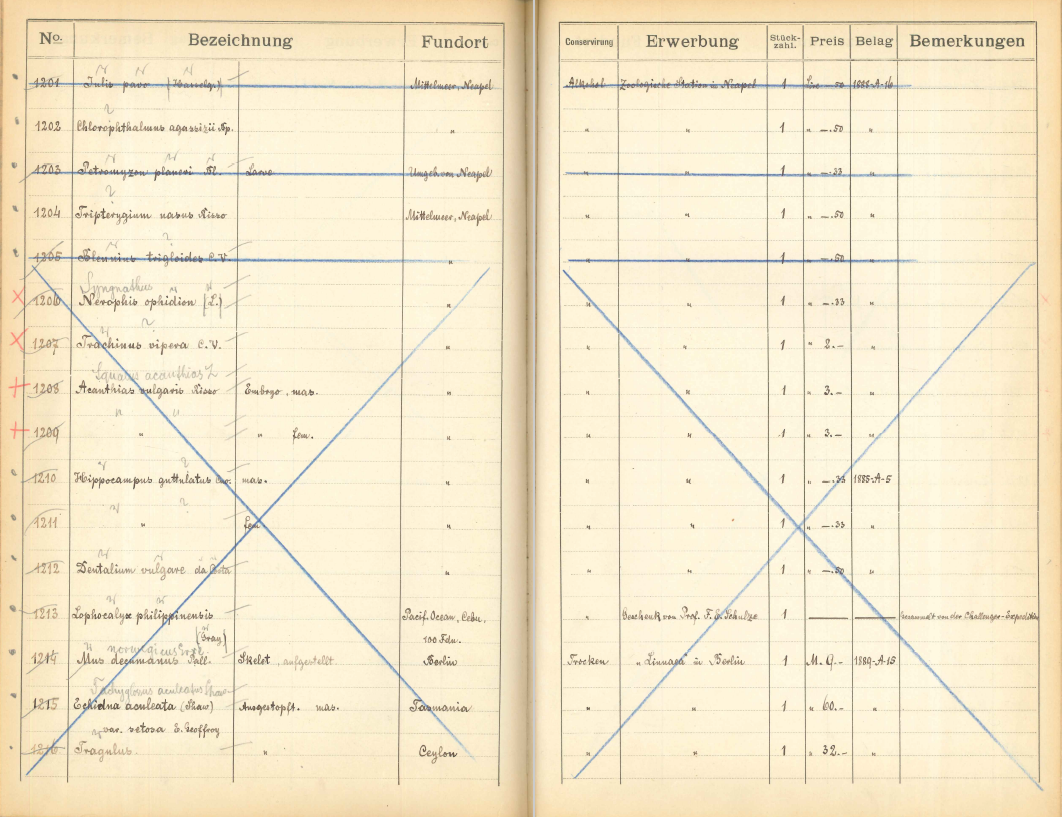
This page from inventory book V(1) records specimens 1201 to 1216. (Zoological Teaching Collection. All rights reserved.)
In its function as a catalogue of new arrivals, inventory book V(1) documented item acquisitions and offered, in the column ‘paid’, for example, an overview of the collection’s annual financial expenses. Entry registers like this were common in other collections of the time; however, there was usually a separation between the first record of arriving items and further inventories, i.e., they were organised in two separate lists. The inventories of the teaching collection appear here in a hybrid format that followed an unconventional, internal logic.
These adaptations derived from the specific character of the teaching collection, which means that the catalogues had a functional relationship with the objects. Specimen records had to reflect the practical use of the objects as teaching materials. The fact that these records were kept for a specific purpose can be seen not just in the type of information contained in the book but also in the choice of cataloguing media. On the level of the content of the knowledge noted down, we can surmise that the category  ‘location’ contains information that reflects the general occurrence of the animal in question. While ‘Africa’, for example, is entered for the taxidermy of a grey parrot (Psittacus erithacus L.) in the teaching collection, thereby referring to the species’ distribution, in the
‘location’ contains information that reflects the general occurrence of the animal in question. While ‘Africa’, for example, is entered for the taxidermy of a grey parrot (Psittacus erithacus L.) in the teaching collection, thereby referring to the species’ distribution, in the  scientific collection of the Zoological Museum, it was important to have precise information about where the specific specimen had been found. This characteristic points to the profile of the teaching collection, whose tasks and organisational logic were different to those of a collection with a research character.
scientific collection of the Zoological Museum, it was important to have precise information about where the specific specimen had been found. This characteristic points to the profile of the teaching collection, whose tasks and organisational logic were different to those of a collection with a research character.
In addition to being catalogued in the inventory books,  labels were attached to the items in around 1900 that contained their names and arrival numbers.4
labels were attached to the items in around 1900 that contained their names and arrival numbers.4
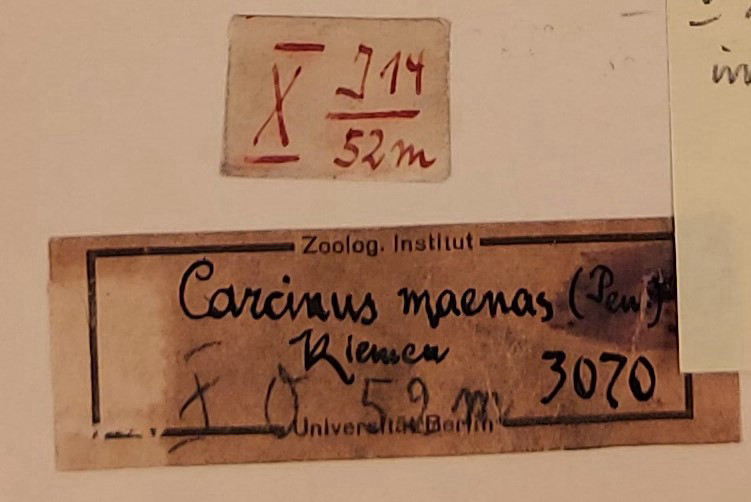
Two labels for the gill of a shore crab (Carcinus maenas). The combination of Roman numerals, letters, and numbers indicates the order of the items in the teaching collection. The number 3070 corresponds to an entry in inventory book V(1) with the same numbering. (Zoological Teaching Collection. All rights reserved.)
The labels supplemented the inventory lists in the records of new arrivals, reducing the amount of object information on the one hand but also containing additional information on the other, like the assignment of a shelf number. A label thus described an item’s place within the collection and also referred to its overarching classification within a  taxonomic system. This made it possible to mobilise individual specimens but also to circulate the knowledge connected with them – an aspect that, in light of the fact that the items were used on a daily basis in university teaching, was of major significance.
taxonomic system. This made it possible to mobilise individual specimens but also to circulate the knowledge connected with them – an aspect that, in light of the fact that the items were used on a daily basis in university teaching, was of major significance.
The inventory books were part of a system of reference that comprised and connected record-keeping media and collection items. They secured information about the items while simultaneously ensuring that the items were used. This was because specimens, just like models or wall charts, had to be found, used, and then stowed away again every day. Reflecting the fact that the items were embedded within a system of academic knowledge transfer, there were some cases where objects were destroyed through use. But how were these  losses recorded? The inventories show that the damaged objects were often replaced with equivalent specimens. Comments recorded these replacements in writing. “Broken and replaced from the holdings of the Royal Zoological Collection. 6.VI.1907”, for example, reads a note that can be found in the record of a wild board skull (Sus scrofa L.) with the number 1396.
losses recorded? The inventories show that the damaged objects were often replaced with equivalent specimens. Comments recorded these replacements in writing. “Broken and replaced from the holdings of the Royal Zoological Collection. 6.VI.1907”, for example, reads a note that can be found in the record of a wild board skull (Sus scrofa L.) with the number 1396.
During the Second World War, the collection was severely damaged. A bombing in the night of 22/23 November 1943 almost completely destroyed a large part of the holdings. It was a loss that, due to its scale, could not just be recorded in a marginal note – as in the case of the broken wild boar’s skull.5 Everything in the collection had to be reinspected after the war during a reinventory. This historic rupture was also mirrored in the choice of cataloguing system. Collection employees now used the catalogue as an inventory list. Following the direct announcement of the “reinventory of the entire collection starting 15 April 1946” in inventory book V(2) are pages with new lists. Specimens received new numbers, and their numbering was interrupted again and again, or contained gaps. These lists of more lists suggest just how tedious and sometimes confusing this inspection work was.

In inventory book V(2), a list of objects with the numbers 375-385 is followed by a list of specimens starting at number 2409, even if it is somewhat muddled. Although the names of objects 2409 and 2414 are listed, they were either missing or were not recorded. (Zoological Teaching Collection. All rights reserved.)
It was probably for this reason that employees stopped fully filling in the preprinted table structure. Reduced to their inventory numbers, names, and a short description of their item type, the specimens were listed one after another. The male embryo of a spiny dogfish (Acanthias vulgaris Risso) preserved in alcohol, which first made its way into the collection as a purchase from the Zoological Station in Naples as number ‘1208’, appears here again as item 2488.

The specimen of a mature male spiny dogfish embryo (Acanthias vulgaris) recorded as number 2488 during the reinventory of the collection holdings in inventory book V(2). (Zoological Teaching Collection. All rights reserved.)
The fact that this is one and the same specimen is revealed in inventory book VII, which begins with entries from the years 1946/1947. Here, the items follow an alphabetical order and are grouped together by their respective species.

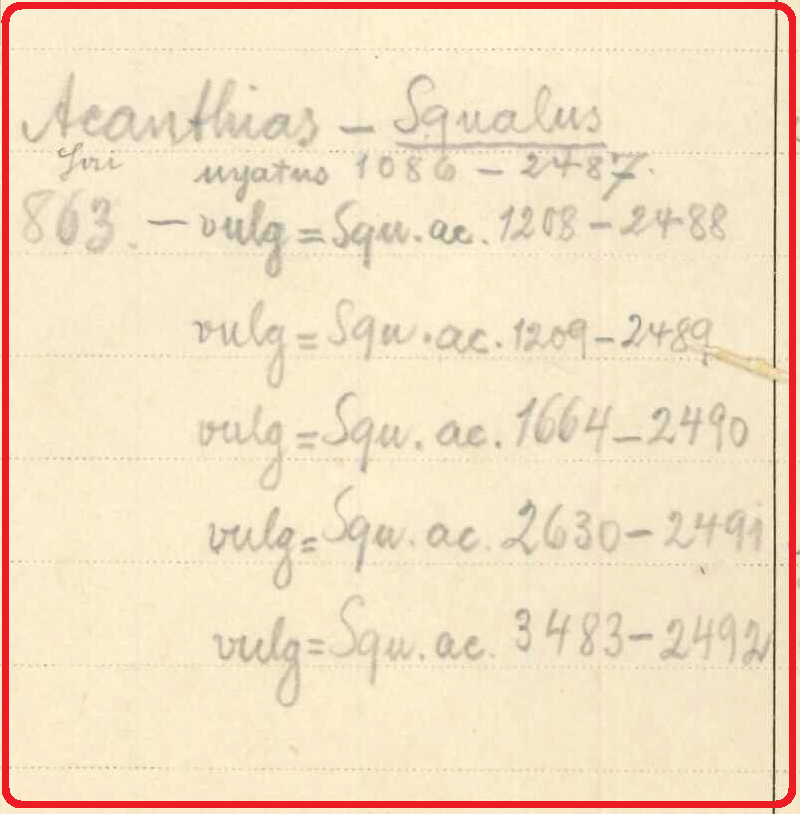
The first page of inventory book VII reveals the graphic and systematic transformation that took place in the practice of record-keeping. A spiny dogfishembryo (Acanthias vulgaris) specimen has been listed below the genus ‘Acanthias’ (or ‘Squalus’) with four other objects, each with the numbers of their previous inventory in inventory books V(1) and V(2). (Zoological Teaching Collection. All rights reserved.)
The grey shark embryo specimen has now been assigned number 863 and is ordered by its genus Acanthias (Squalus), but also includes the numbers of its previous records. This overview was accompanied by updates to object descriptions. Acanthias vulgaris Risso became Squalus acanthias L. The first inventory book V(1) was also adjusted to bring it up to date with the changes that had been taking place in zoological classification and the corresponding naming conventions. Employees completed entry ‘1208’ with a comment in pencil that noted the Linnaean description.

Entry number ‘1208’ in inventory book V(1) contains the first record of the grey shark embryo specimen. The pencil correction to the Latin name reflects the revisions made to inventory books V(1) und V(2) during reinventory. (Zoological Teaching Collection. All rights reserved.)
This is the first time that the orientation towards certain classification standards and a new taxonomic systematics becomes visible here in the inventory book itself as a component of the record-keeping process. This process continuously put the specimens into new orders and contexts of meaning, and made it possible to count and circulate them.6 The inventory book was a tool for collection managers that reflected the struggle to find consistent and effective forms of record-keeping, which, however, it also influenced.7 Attempts to adapt the inventory books accordingly clearly failed, as the graphic and systematic restructuring of the cataloguing process in inventory book VII was only carried out over a few pages and was not completed.
Inventory book VII is testament to this development and was also shaped by further changes to the format and the systematics of cataloguing. Numbering was no longer guided by a chronological listing of object arrivals, but ordered specimens by their taxonomic ‘class’ (fish, amphibians, reptiles etc.). All of this ultimately resulted in a list structure that can be identified as a transcription of the entries in inventory book V.8 The organisation of the collection seemed to have returned to the first form of record-keeping, the list.
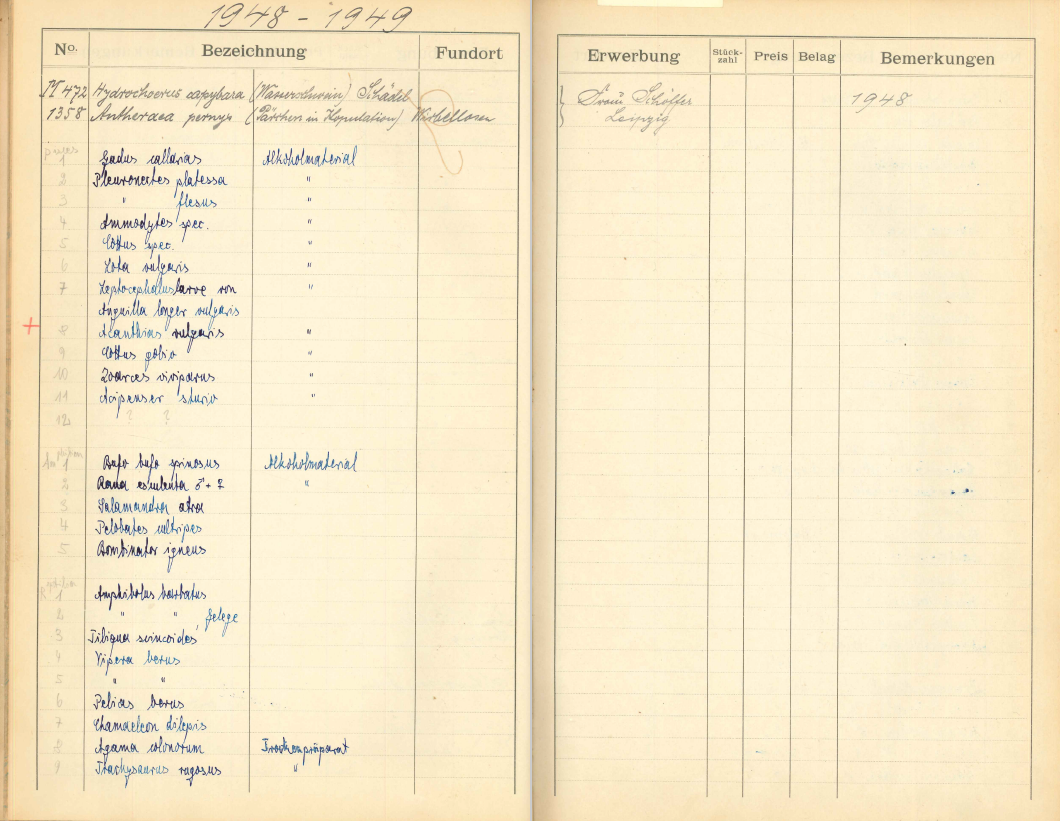
This page from inventory book VII shows how species were grouped into animal classes, e.g., fish, amphibians, reptiles, etc. The red cross marks the entry for the spiny dogfish. (Zoological Teaching Collection. All rights reserved.)
Like the collection items themselves, the inventories show signs of wear and tear. The pages in inventory book V display colour codes, deletions, and notes made in pencil. These were added after the fact and thus were not part of the originally intended practice of record-keeping. The additions were probably made when the specific pieces of information were being transferred to inventory book VII. The annotations overlap and emphasise the various temporal layers. It is precisely for this reason that they are confusing to outside ‘readers’ and new collection employees. Decoding and correctly classifying historical objects is like performing detective work that, despite meticulously comparing various entries, numbers, and handwriting, only seldom leads to a precise conclusion.
Crosses, circles, and dots beside entries in inventory book V probably stand for ‘preserved’ or ‘lost’. The records were transferred to catalogue VII accordingly. Acanthias vulgaris Risso was thus recorded under the number ‘1208’ using its old designation..

This page from inventory book VII shows how entries 1185 to 1216 were transferred from inventory book V(1), including the spiny dogfish embryo with the number ‘1208’. An additional column has been added to the preprinted table that records the item’s shelf number. (Zoological Teaching Collection. All rights reserved.)

This page from inventory book V(1) shows the first records of specimens 1201 to 1216 and the corresponding annotations. Crosses and dots at the edge of the page probably show whether the objects had gone missing or were still in the collection. The pages have been crossed out and thus marked as invalid. (Zoological Teaching Collection. All rights reserved.)
Lost or destroyed specimens were identified with spaces in the inventory books or replaced with other items, although most of them were not specimens of the same species or the same animal. These changes, adjustments, rewritings, and transfers emphasise the practical level of the cataloguing process, which developed in practice and was formed and reformed by its materiality and mediality.9 Moreover, they reveal the limits of keeping inventory in book form, which was wedded to the list system – a practice of record-keeping that, due to its compact and linear form of cataloguing, did not stand up to emergent structures and changes. As a consequence, employees of the institute wrote over the preprinted table structure, created new lists of lists, and verified existing entries or marked them as invalid.10 In spite of these strategies and aids, it was not possible to ensure that knowledge and collection items would be transferred and preserved without any gaps. Only a few objects in the collection today can be clearly attributed to a precise acquisition context using the records. Moreover, this situation has been exacerbated by a change in record-keeping media, as Berlin’s teaching collection began using a  system of index cards to organise the collection in 1968. Today, these practices sit side by side with digital technologies and
system of index cards to organise the collection in 1968. Today, these practices sit side by side with digital technologies and  databases which cannot simply replace them, but expand and transform their practical use and
databases which cannot simply replace them, but expand and transform their practical use and  the worlds they create.
the worlds they create.
The inventory books have become historical documents. It is these discontinuities and functional shifts in  record-keeping practice that point to its practical application. The knowledge gained in experience determined how organisational work was carried out in the collection. This knowledge only took shape while using the record-keeping systems that it also produced. In order to read these kinds of historical inventories, academics often have to rely on the expertise of collection employees. The inventories of the teaching collection are examples of the administrative processes that determine everyday life at the institute and in the collection as anonymous structures that rely on oral transmission in many cases.
record-keeping practice that point to its practical application. The knowledge gained in experience determined how organisational work was carried out in the collection. This knowledge only took shape while using the record-keeping systems that it also produced. In order to read these kinds of historical inventories, academics often have to rely on the expertise of collection employees. The inventories of the teaching collection are examples of the administrative processes that determine everyday life at the institute and in the collection as anonymous structures that rely on oral transmission in many cases.
- This image is from the private collection of Elsi Hedström, the granddaughter of Franz Eilhard Schulze. The people depicted have been identified by Stefan Richter; cf. “Franz Eilhard Schulze und die Zoologische Lehrsammlung der Berliner Universität”. In Theater der Natur und Kunst: Theatrum Naturae et Artis. Horst Bredekamp, Jochen Brüning, and Cornelia Weber (eds.). Berlin: Henschel, 2000.↩
- Anke te Heesen. “Die doppelte Verzeichnung: Schriftliche und räumliche Aneignungsweisen von Natur im 18. Jahrhundert”. In Gehäuse der Mnemosyne: Architektur als Schriftform der Erinnerung. Harald Tausch (ed.). Göttingen: Vandenhoeck & Ruprecht, 2003: 263-286.↩
- Cf. Cornelia Vismann. Akten: Medientechnik und Recht. Frankfurt a.M.: Fischer, 2011: 21ff.; Hannah Turner. “Critical Histories of Museum Catalogues”. Museum Anthropology 39, no. 2 (2016): 102-110. https://doi.org/10.1111/muan.12118.↩
- These labels have only been preserved in rare cases as they were removed during the institutional restructuring that took place in the postwar period. Only objects that were given to other institutions before this time and that were later given back to the institute still bear these old labels. In the chronicles of Friedrich-Wilhelms-Universität zu Berlin, however, the acquisition of a typewriter “to produce labels” was recorded for fiscal year 1894/1895. See anonymous. “Chronik der königlichen Friedrich-Wilhelms-Universität zu Berlin für das Rechnungsjahr 1894/95”. In Chronik der Friedrich-Wilhelms-Universität, vol. 8. Berlin: 113. https://www.digi-hub.de/viewer/resolver?urn=urn:nbn:de:kobv:11-d-6653534 (20.06.2021).↩
- Günther Tembrock. “Das Zoologische Institut der Humboldt-Universität von 1945 bis zur Gründung der Sektion Biologie”. Wissenschaftliche Zeitschrift der Humboldt-Universität zu Berlin (1985): 281.↩
- Staffan Müller-Wille. “Names and Numbers: ‘Data’ in Classical Natural History, 1758-1859”. Osiris 32, no. 1 (2017): 109-128.↩
- Staffan Müller-Wille and Isabelle Charmantier. “Lists as Research Technologies”. Isis 103, no. 4 (2012): 744.↩
- It is not possible to precisely date this overview. However, it follows the records of object arrivals in 1959/1960.↩
- Turner, 2016: 18f.↩
- Cf. Vismann, 2011.↩